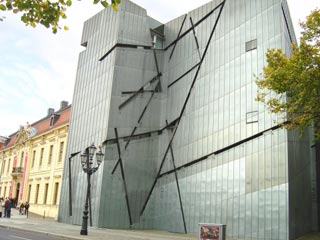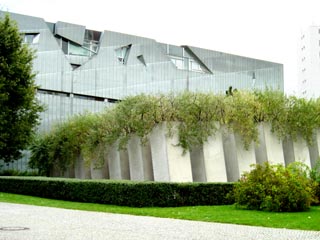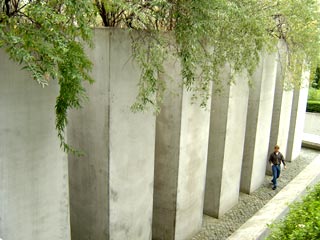












![]() The Jewish Museum presents the 2000-year history of Jews in Germany from the Middle Ages to the present. It is the biggest Jewish Museum in Europe. It is accommodated at the extension of the Berlin-Museum created by Daniel Libeskind. Even the fantastic draft had been already celebrated by architecture lovers all over the world. The zinc clad building has a forked floor plan, in a startling form of an exploded Star of David with some seemingly coincidental window slits. Libeskind linked with an 'imaginary net the residential areas of prominent Jewish and non-Jewish Berlin citizens'.
The Jewish Museum presents the 2000-year history of Jews in Germany from the Middle Ages to the present. It is the biggest Jewish Museum in Europe. It is accommodated at the extension of the Berlin-Museum created by Daniel Libeskind. Even the fantastic draft had been already celebrated by architecture lovers all over the world. The zinc clad building has a forked floor plan, in a startling form of an exploded Star of David with some seemingly coincidental window slits. Libeskind linked with an 'imaginary net the residential areas of prominent Jewish and non-Jewish Berlin citizens'.
![]() The exhibits of the permanent exhibits will surprise you. Jews are not only shown as victims, but most of all as a fellow citizen, who formed culture and economic considerably. The exhibition presents 4000 exhibits among them 1600 originals, exclusively Jewish documents and items sometimes everyday things taken into exile by emigrants in the thirties, which highlights the German-Jewish culture and history from the Middle Ages to the present.
The exhibits of the permanent exhibits will surprise you. Jews are not only shown as victims, but most of all as a fellow citizen, who formed culture and economic considerably. The exhibition presents 4000 exhibits among them 1600 originals, exclusively Jewish documents and items sometimes everyday things taken into exile by emigrants in the thirties, which highlights the German-Jewish culture and history from the Middle Ages to the present.

![]() Libeskind's triumphal building is itself cenotaph thanks to its startling form of a transfixed thunderbolt. Dark corridors where every emotion freezes, empty rooms called 'Voids', which depicts the absence of Jewish life in Berlin invite visitors to a meditative contemplation. A cold breeze blows up from the cellar corridors. Three corridors cut through the basement: the 'Axis of Exile' (with inserted display cabinets, where testimonials of the expelled families have been collected with simple labels with the most famous escape destinations); the 'Garden of the Exile' with its lopsided levels, which oddly threaten our poise; the 'Road of Obliteration' (these also lined with display cabinets with documents of exemplary fates); the Holocaust-Axis, where the walls carry the names of the most infamous extermination camps and the way of suffering of individual victims with documents and objects; the 'Holocaust-Tower', a completely naked grey concrete funnel, which towers over three floors. Its walls tapered closed through a black metal door and only illuminated by a weak skylight from slit like holes - a place of abandonment, where nobody escapes unmoved; the 'Axis of Continuity', leads to long staircase from where the accesses branch off to the exhibition rooms. The interior design at the exhibition rooms submits to the complex, deliberate confusion of lines and areas, which the architect created through the arrangement of window slits, the anomaly of the walls and the unexpected corner. Still the Jewish Museum is not a memorial, not a house of deat,h but a 'House of Life'.
Libeskind's triumphal building is itself cenotaph thanks to its startling form of a transfixed thunderbolt. Dark corridors where every emotion freezes, empty rooms called 'Voids', which depicts the absence of Jewish life in Berlin invite visitors to a meditative contemplation. A cold breeze blows up from the cellar corridors. Three corridors cut through the basement: the 'Axis of Exile' (with inserted display cabinets, where testimonials of the expelled families have been collected with simple labels with the most famous escape destinations); the 'Garden of the Exile' with its lopsided levels, which oddly threaten our poise; the 'Road of Obliteration' (these also lined with display cabinets with documents of exemplary fates); the Holocaust-Axis, where the walls carry the names of the most infamous extermination camps and the way of suffering of individual victims with documents and objects; the 'Holocaust-Tower', a completely naked grey concrete funnel, which towers over three floors. Its walls tapered closed through a black metal door and only illuminated by a weak skylight from slit like holes - a place of abandonment, where nobody escapes unmoved; the 'Axis of Continuity', leads to long staircase from where the accesses branch off to the exhibition rooms. The interior design at the exhibition rooms submits to the complex, deliberate confusion of lines and areas, which the architect created through the arrangement of window slits, the anomaly of the walls and the unexpected corner. Still the Jewish Museum is not a memorial, not a house of deat,h but a 'House of Life'.

![]() At the E.T.A. Hoffmann-Garden outside the building represent 49 planted steles on a sloping surface the bitter experience of Jewish emigration. The multimedia museum's show shows collections of antique treasures, film excerpts and placards, accessible installations. The museum ties the history of Jews in Berlin to the first Jewish museum, which was opened on the 24 January 1933 at the Oranienburger Straße just before Hitler came to power. It was closed for good after the anti-Semitic surge night in 1938. There are regular special exhibitions, display cabinet presentations also several multimedia produced stories at the Rafael Roth Learning Center as well as concerts and readings. Events held during the Culture Summer include also the museum's garden and attract many young visitors.
At the E.T.A. Hoffmann-Garden outside the building represent 49 planted steles on a sloping surface the bitter experience of Jewish emigration. The multimedia museum's show shows collections of antique treasures, film excerpts and placards, accessible installations. The museum ties the history of Jews in Berlin to the first Jewish museum, which was opened on the 24 January 1933 at the Oranienburger Straße just before Hitler came to power. It was closed for good after the anti-Semitic surge night in 1938. There are regular special exhibitions, display cabinet presentations also several multimedia produced stories at the Rafael Roth Learning Center as well as concerts and readings. Events held during the Culture Summer include also the museum's garden and attract many young visitors.
![]() Address:
Address:
Jüdisches Museum Berlin
Lindenstraße 9-14
10969 Berlin
![]() 030 25993-300
030 25993-300
Fax: 030 25993-409
![]() Transport Links:
Transport Links: ![]() U1, U6 Hallesches Tor, U6 Kochstraße
U1, U6 Hallesches Tor, U6 Kochstraße ![]() M29, M41, 265
M29, M41, 265
Metered parking is available.
![]() For information about the offered guided tours, events and special exhibitions, please refer to the Homepage des Jüdischen Museum.
For information about the offered guided tours, events and special exhibitions, please refer to the Homepage des Jüdischen Museum.